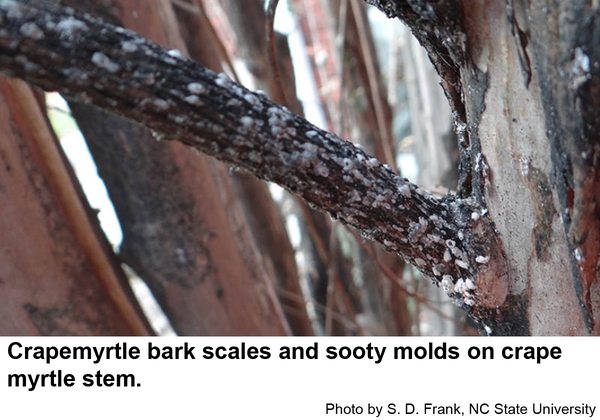Description and Biology
Adult female crapemyrtle bark scales, Acanthococcus lagerstroemiae, are dark red with short legs and antennae and long, thread-like mouthparts. The insect is usually hidden from view by the egg sac or ovisac, a white covering of felted or matted white threads. The sac is about 1/8 inch long and 1/16 inch thick. Pink to reddish purple eggs are laid within the egg sac, occupying the void left by the female's shrinking body. Eggs are laid in late April. They hatch about 3 weeks later in early May. This new generation matures during the summer and produces eggs that hatch in September. Newly hatched nymphs, called crawlers, are pink, tiny and crawl out of the egg sac onto the bark where they settle especially near twig crotches. Crawlers soon penetrate the bark with long, thread-like mouthparts, and begin to feed by sucking out sap. They then begin excreting honeydew and secreting white threads. These nymphs are inconspicuous and practically free of any waxy covering when very young. Mature females tend to feed in crotches and on twigs. Adult males have two wings and are tiny gnat-like insects. Male nymphs tend to feed on leaves. Crapemyrtle bark scales overwinter as nymphs feeding through the bark.
Host Plants
In the US, crapemyrtle is the primary host, but American beautyberry has also been reported. In Asia crapemyrtle bark scales infest other hosts.
Residential Recommendations
With most contact insecticide sprays, chemical control of the crapemyrtle bark scales and their eggs inside the ovisacs is difficult (unless the crawlers are outside the ovisacs). When they hatch, tiny, new nymphs crawl onto the bark and are relatively vulnerable to sprays. Late spring and late summer are the two best times to spray. Imidacloprid, pyrethroids, or summer oil should give adequate control of the nymphs, especially nymphs that have not already secreted their white, felted covering. When used as directed, pyrethroids are very toxic to insects but are not particularly hazardous to humans and pets (other than fish—avoid using pyrethroids around pools, ponds, and streams). Imidacloprid, when applied to the soil as a granular formulation or drench in very early spring should give season long control. In addition, an application of a horticultural oil is moderately toxic to scale crawlers, and it will help weather away sooty molds that have accumulated in the honeydew these scales excrete.
Other Resources
- Biology and Management of the Crapemyrtle Bark Scale: Landscape and Nursery Grower. Mike Merchant, M. and M. Gu. Reviewed by: M. Merchant & J. Hurley (2018). Texas A&M Extension Entomology.
- Crapemyrtle Bark Scale: A New Insect Pest. Robbins, J. et al. No Date, after 2014. University of Arkansas Division of Agriculture, Little Rock. FSA7086
- Crape myrtle bark scale: New tree pest has arrived in NC. Frank, S. D. 2016. Insect Ecology and Integrated Pest Management, NC Cooperative Extension.
- Horticultural Oils for Ornamental Plants. Frank, S. D. et al. 2023 (revised). Entomology Insect Notes, NC State Extension Publications.
- Extension Plant Pathology Publications and Factsheets
- Horticultural Science Publications
- North Carolina Agricultural Chemicals Manual
For assistance with a specific problem, contact your local Cooperative Extension Center.
This Factsheet has not been peer reviewed.
Publication date: Nov. 8, 2023
Recommendations for the use of agricultural chemicals are included in this publication as a convenience to the reader. The use of brand names and any mention or listing of commercial products or services in this publication does not imply endorsement by NC State University or N.C. A&T State University nor discrimination against similar products or services not mentioned. Individuals who use agricultural chemicals are responsible for ensuring that the intended use complies with current regulations and conforms to the product label. Be sure to obtain current information about usage regulations and examine a current product label before applying any chemical. For assistance, contact your local N.C. Cooperative Extension county center.
N.C. Cooperative Extension prohibits discrimination and harassment regardless of age, color, disability, family and marital status, gender identity, national origin, political beliefs, race, religion, sex (including pregnancy), sexual orientation and veteran status.




